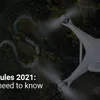Ministry of Civil Aviation releases airspace map for drone operations in India
The Ministry of Civil Aviation has released the airspace map for drone operations to indicate the permission and no-permission zones. The map can be accessed using the Digital Sky Platform.
Ministry of Civil Aviation has released the airspace map for drone operations in India to indicate the permission and no-permission zones for flying drones. The map can be accessed using the Directorate General of Civil Aviation’s (DCGA) Digital Sky Platform.
This development comes a day after Jyotiraditya Scindia, Union Minister for Civil Aviation, revealed that the map will be uploaded on the digital platform.

Representational Image
According to the official statement by the Ministry, the drone airspace map is an interactive map that "demarcates the yellow and red zones across the country". The statement revealed that:
- The green zone is the airspace up to 400 feet that has not been designated as a red or yellow zone and up to 200 feet above the area located between eight to 12 km from the perimeter of an operational airport.
- In green zones, no permission is required for operating drones with an all-up weight up to 500 kg.
- The yellow zone is the airspace above 400 feet in a designated green zone; above 200 feet in the area located between eight to 12 km from the perimeter of an operational airport, and above ground in the area located between five to eight km from the perimeter of an operational airport.
- Drone operations in the yellow zone will require permission from the concerned air traffic control authority such as AAI, IAF, Navy, HAL among others as needed.
- The yellow zone has been reduced from 45 km earlier to 12 km from the airport perimeter.
- Meanwhile, the red zone is a ‘no-drone zone’, and drones in this zone can be operated only after receiving permission from the central government.
The official statement also clarified that the airspace map may be modified by the “authorised entities from time to time.” It also revealed that drone operators will need to check the latest airspace map mandatorily to keep a check on any changes in the zone boundaries.
This drone airspace map comes in after the central government released Drone Rules, 2021 on August 25 with an aim to accelerate growth in this sector. The rules for drone operations have been liberalised by reducing the number of forms that need to be filled to operate them from 25 to five, and decreasing the types of fees charged from the operator from 72 to four.
Taking to Twitter, Prime Minister Narendra Modi said that the new drone rules usher in a landmark moment for this sector in India.
“The rules are based on the premise of trust and self-certification. Approvals, compliance requirements and entry barriers have been significantly reduced. The new Drone Rules will tremendously help start-ups and our youth working in this sector. It will open up new possibilities for innovation and business. It will help leverage India’s strengths in innovation, technology and engineering to make India a drone hub,” he said.
As a follow-through, last week, the government also approved Production-Linked Incentive (PLI) scheme for drones and drone components.
According to the official statement, both the PLI scheme and new drone rules are intended to “catalyse super-normal growth” in the drone sector.
The total amount allocated is Rs 120 crore spread over three financial years. This amount is nearly double the combined turnover of all domestic drone manufacturers in FY 2020-21.
YourStory’s flagship startup-tech and leadership conference will return virtually for its 13th edition on October 25-30, 2021. Sign up for updates on TechSparks or to express your interest in partnerships and speaker opportunities here.
For more on TechSparks 2021, click here.
Edited by Kanishk Singh








